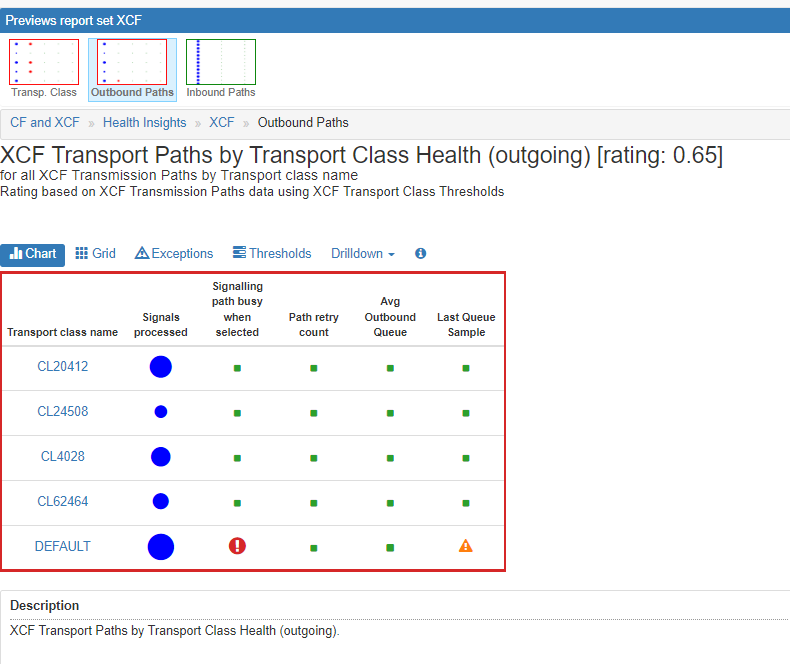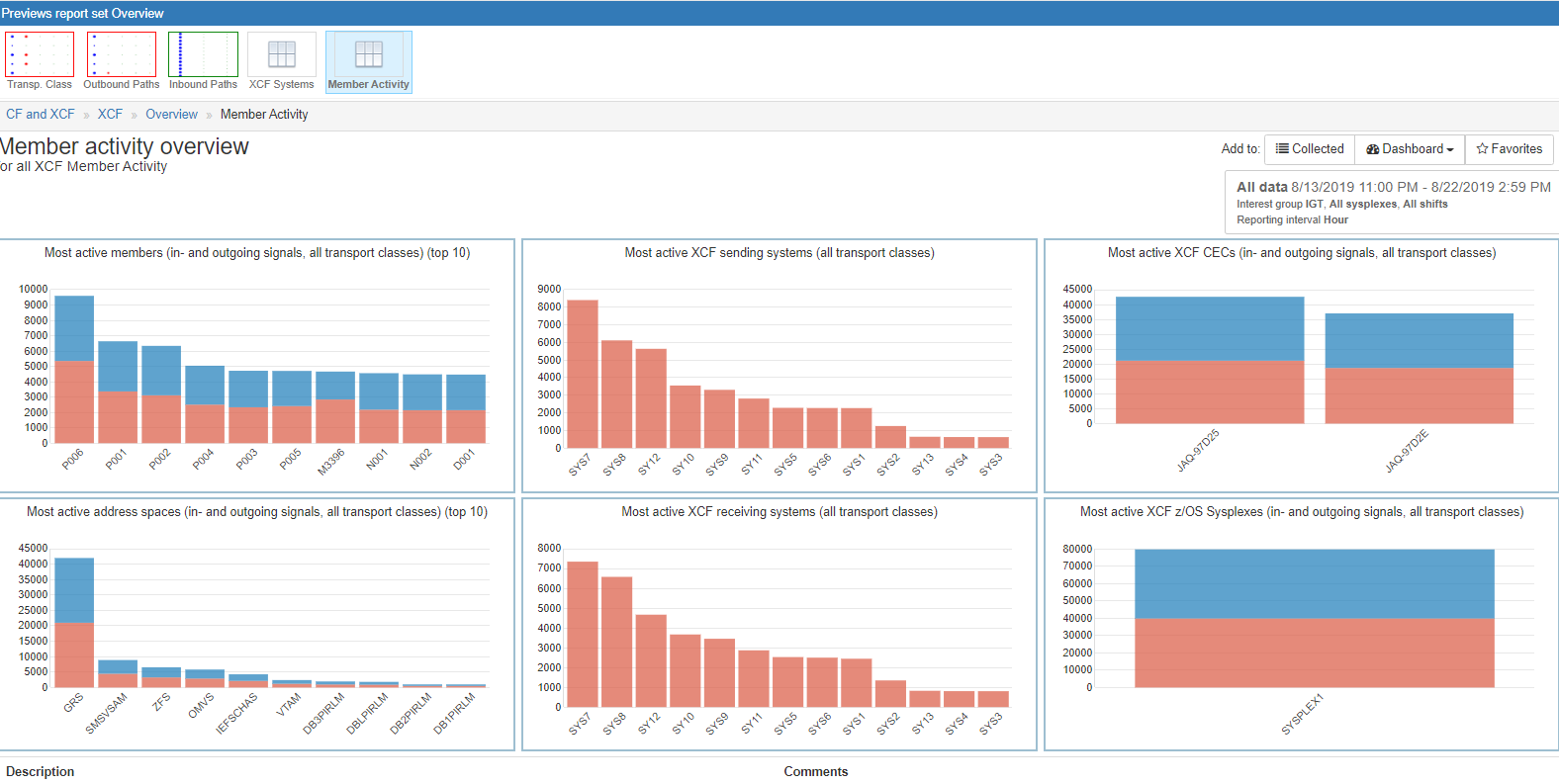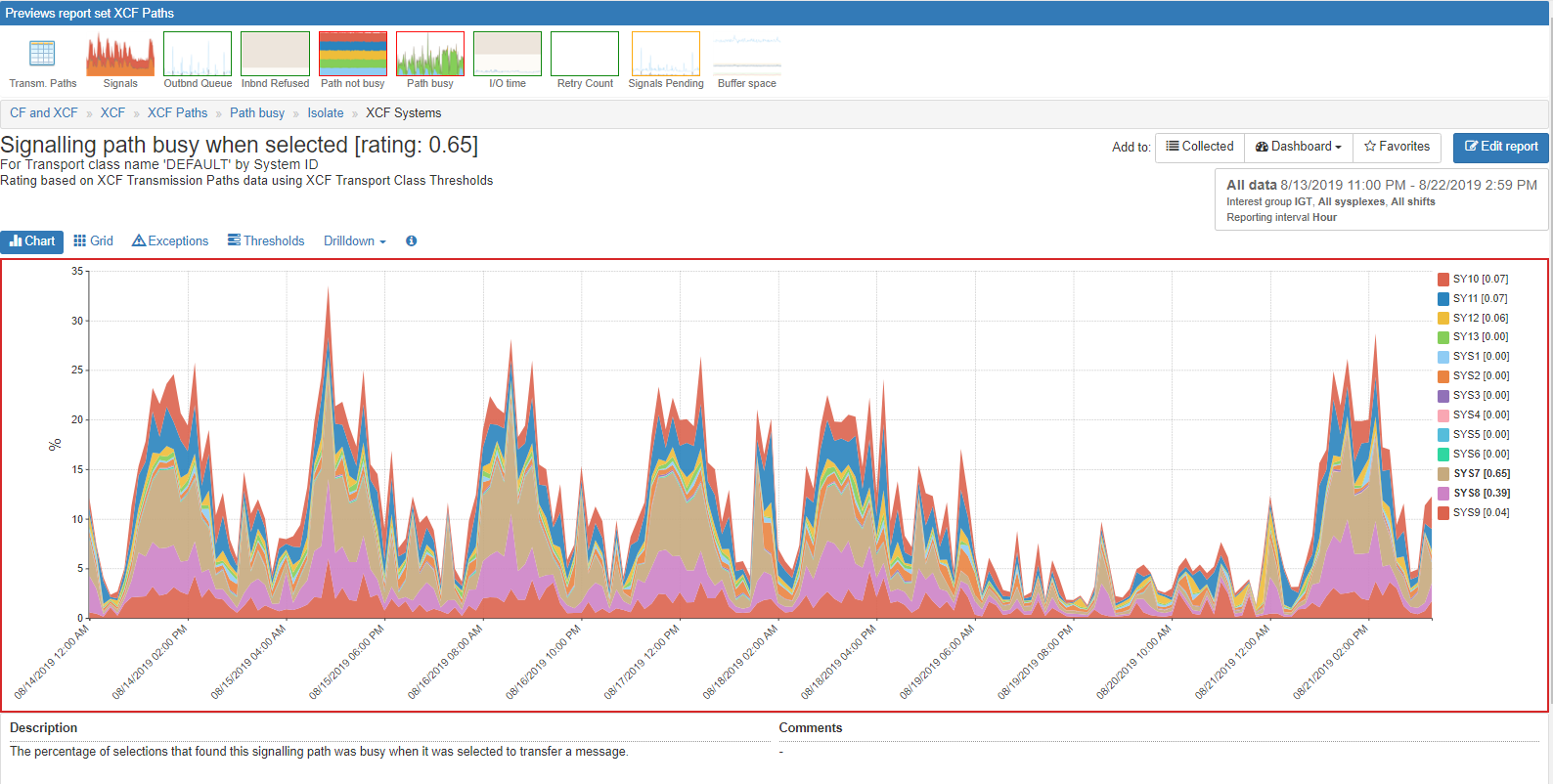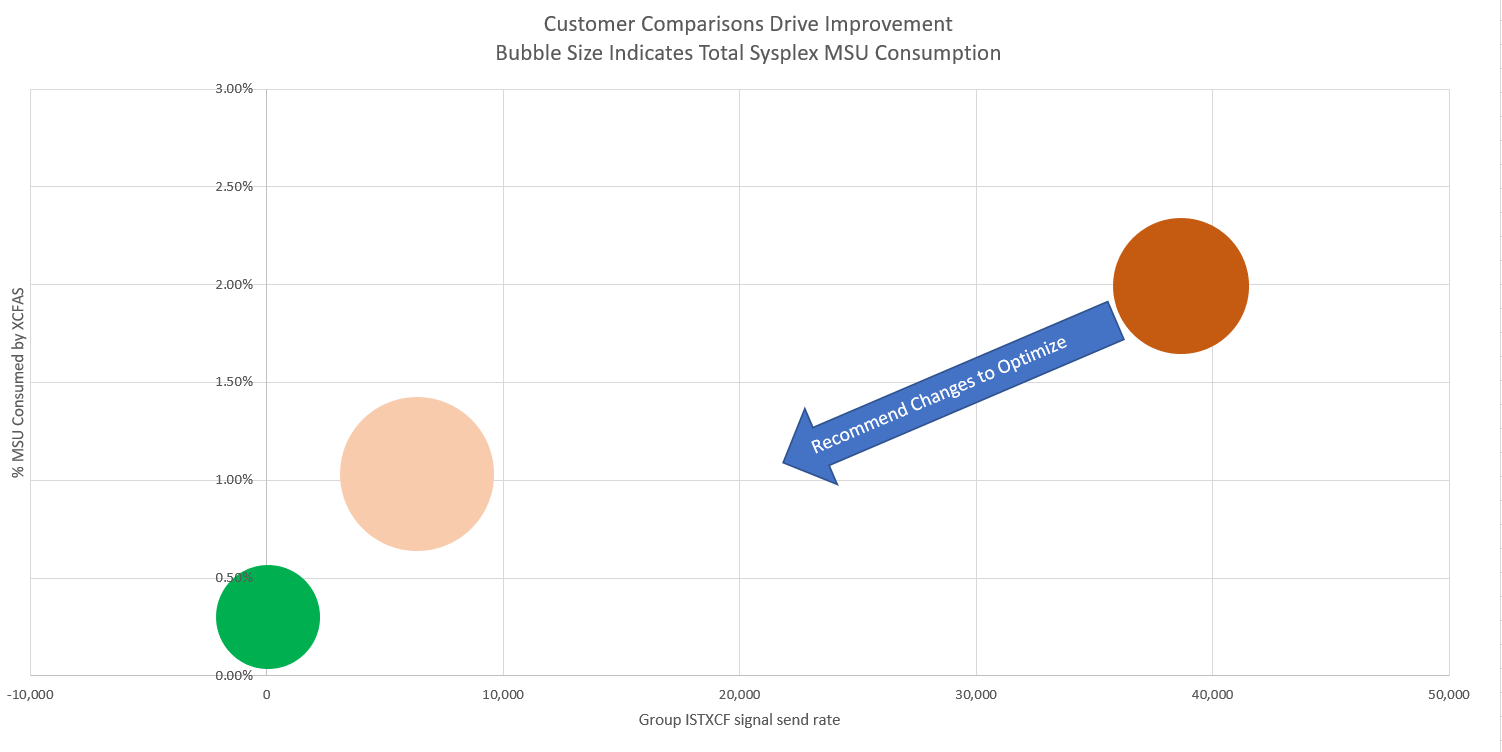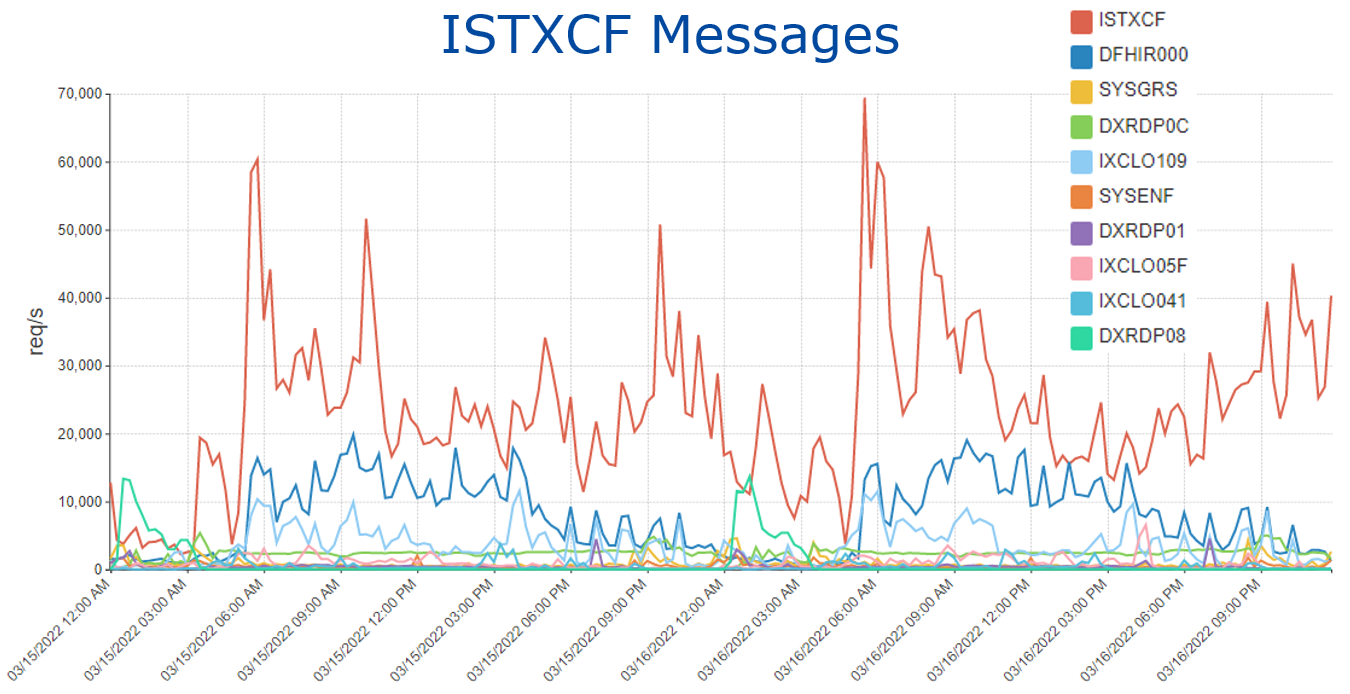Tune XCF to Reduce MIPS and Save Money
The Cross System Coupling Facility (XCF) component of z/OS plays a fundamental role in a Parallel Sysplex, but it also burns a lot of MIPS and generates a lot of the Coupling Facility (CF) traffic that could be avoided with best-practice configurations.
In this Tailored Services Engagement, IntelliMagic consultants will work with your site to tune and optimize your XCF configuration to optimize performance, reduce MIPS, and save money.
XCF Optimization Challenges
However, without issues heavily impacting availability or performance to draw an analysts attention, tuning XCF is often not high on a performance analysts’ to-do list.
A larger challenge exists in the lack of user-friendly RMF XCF reports making tuning and optimization exercises more challenging than the perceived benefits.
XCF Optimization Analysis
Subsequently, the consultant will identify whether GDPS (Geographically Dispersed Parallel Sysplex) is active within specific sysplexes. In addition, a review of address space activity and reporting class(es) will be performed to explore optimization opportunity size. The CF and ICF configurations will be reviewed along with OSA configurations to ensure traffic moves can be easily accommodated.
To reduce the load on XCF, the IntelliMagic consultant will review configurations and assist with plans for the appropriate changes to the VTAM and TCP/IP definitions. Savings of MIPS and reduction of XCF messages through the Coupling Facilities will be shown in charts displaying the before and after situation. If there is a higher volume of TCP/IP traffic in your sysplex, it is worthwhile to let the IntelliMagic consultant check how much of the XCF traffic is related to the ISTXCF group.
Key Areas for Optimization and MIPS Reduction
After assessing your site, our consultants will consult with you about your unique environment and cover all the potential areas where MIPS reductions are possible.
The key analysis that the IntelliMagic consultant will perform as part of this service is to review operational efficiencies, risks, performance, and SLOs. This includes:
- Profile the workload behavior of XCF activity. Each sysplex may have different workloads driving the XCF traffic. A separate view of each sysplex XCF traffic will include a review of current state, along with some analysis of trends depending on the amount of historical data available.
- Message fit metrics, request rejects, path busy conditions will be reviewed. Specific dimensions of activity will be reviewed down to system, address space, and XCF members over time.
- Review configurations to ensure redundancy is place to minimize risks. Single paths will be highlighted so that the customer can implement changes to ensure redundancy for XCF traffic is in place.
- Review XCF in context with other customers to spotlight improvement opportunities.
- Member Activity ISTXCF – confirms TCPIP traffic over XCF.
The IntelliMagic consultant will establish opportunities and develop reporting measures. Next steps for optimization might include system definition changes that would result in the conversion of some TCP/IP traffic from XCF to OSA. The evaluation of traffic would be used to assist the customer through the steps needed to recover the savings.
XCF Transport Class Health
The IntelliMagic consultant will investigate the health of the XCF Transport Classes. For instance, they will check the “Percentage of message fit conditions” and if too many messages do not find an appropriate buffer, the XCF buffers for this transport class need to be reconsidered. In addition, the consultant will assist your team to ensure the z/OS V2R4 introduced enhancements in cross-system coupling facility (XCF) signaling services are leveraged.
Activity Workload Profiling
Each sysplex may have different workloads driving the XCF traffic.
A separate view of each sysplex XCF traffic will include a review of current state, along with some analysis of trends depending on the amount of historical data available. Message fit metrics, request rejects, and path busy conditions will be reviewed.
Specific dimensions of activity will be reviewed down to system, address space, and XCF members over time.
Customer Matrix of Problems and Opportunities
Review XCF activity in context with other customers anonymized data to build awareness of existing workloads and identify potential opportunities.
The usage comparisons of some more common exploiters of XCF will be evaluated to spotlight any unique improvements that can be made.
Customized Consultation for Cross-System Coupling Facility Optimization
After engaging with IntelliMagic’s customized XCF Optimization service, z/OS sites have experienced significant MIPS reductions and a reduction of performance issues.
During the service engagement, our z/OS consultants will:
- Meet with your key stakeholders to discuss your specific requirements for an XCF optimization study
- Collect the required measurement data from your site
- Provide ongoing reporting to your site, demonstrating the optimization results and value
- Provide a mid-engagement checkpoint to review preliminary findings
- Present any identified options for risk abatement, performance improvements, and best practices
- Conduct a final presentation/workshop covering the entire engagement and results
- Present a formal report describing the findings of the XCF optimization study
Request a Free Consultation
Request a free consultation with an IntelliMagic expert to answer your questions regarding this services engagement and gain an understanding of expected outcomes, timelines, process, and pricing. The engagement will be tailor fit to meet your specific environment and needs.
zSystems Performance Management
Optimize z/OS Mainframe Systems Management with Availability Intelligence
Benefits
Db2 Performance Management
Prevent Availability Risks and Optimize Db2 Performance
Benefits
Easy visibility into key Db2 metrics through SMF records is crucial to proactively prevent availability risks and to effectively manage and optimize performance.
CICS Performance Management
Monitor and Profile CICS Transactions and Regions with IntelliMagic Vision
Benefits
IntelliMagic Vision enables performance analysts to manage and optimize their z/OS CICS transactions more effectively and efficiently, as well as proactively assess the health of their CICS regions.
Virtual Tape Performance Management
Proactively Manage Virtual and Physical Tape Environments
Benefits
IntelliMagic Vision enables performance analysts to manage and optimize their z/OS Virtual Tape environments more effectively and efficiently.
Disk & Replication Performance Management
Automatically Detect Disk Performance Risks & Quickly Resolve Issues
Benefits
IntelliMagic Vision enables performance analysts to manage and optimize their z/OS Disk and Replication environment more effectively and efficiently.
MQ Performance Management
Optimize and Analyze MQ Activity and Performance
Benefits
IntelliMagic Vision enables performance analysts to manage and optimize their z/OS MQ configurations and activity more effectively and efficiently, as well as proactively assess the health of their queue managers.
z/OS Network Performance Management
Automatically Monitor Mainframe Network Security and Protect Your Data
Benefits
IntelliMagic Vision automatically generates GUI-based, interactive, IBM best-practice compliant rated reports that proactively identify areas that indicate potential upcoming risk to TCP/IP health, performance, and security.
z/OS Connect: Modern Mainframe API Environment
Optimizing Mainframe API Monitoring for Improved Resource Management
Benefits
What is Cross-System Coupling Facility (XCF)?
At the heart of a sysplex is the XCF. As its name suggests, XCF handles communication between logical partitions (LPARs) or CPCs. Communication between these LPARs is effectively (from a TCP/IP perspective) instantaneous.
TCP/IP takes advantage of the communication capabilities of the XCF in a sysplex in three different ways:
- It maintains awareness of the status (health) of a TCP/IP instance within the sysplex.
- It determines workload levels within each LPAR in the sysplex through Workload Manager (WLM).
- It can send IP traffic among the LPARs.
VIPAROUTE is often the best choice for connection routing:
- Exploits network redundancy
- Often it is fast or faster than XCF
- Does not use Coupling Facility CPU cycles, which is often a limited resource.
ISTXCF – XCF and TCP/IP
One of the largest users of XCF might be ISTXCF, which is the XCF group that Communications Server uses for both VTAM and TCP/IP traffic between members of the sysplex.
TCP/IP can use one of three mechanisms to communicate between the systems in a sysplex:
- XCF
- HiperSockets, if the two systems are in the same CPC
- OSA (Open Systems Adapter), if the two systems are in different CPCs
If you are using Dynamic VIPAs (Virtual IP Addresses) TCP will send its packets:
- Over XCF – this is the default.
- Over a HiperSocket, if ISTIQDIO is defined in the VTAM Dynamic XCF Sysplex Distributor connection routing between LPARs on the same CPC
- Over an OSA adapter, if a VIPAROUTE is defined for systems that are not in the same CPC.
